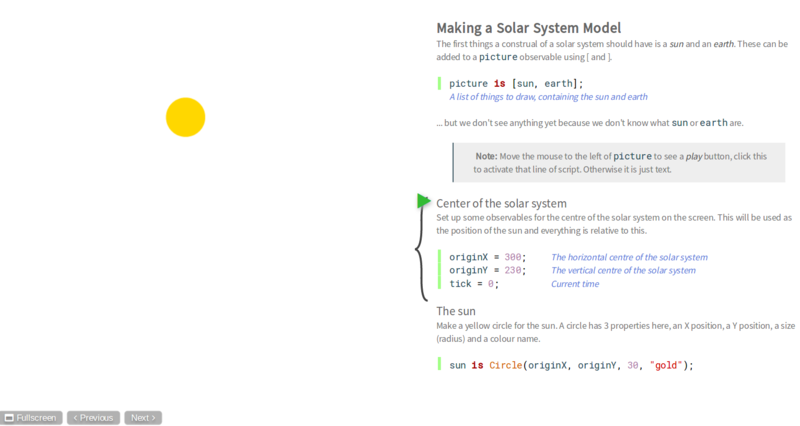Construit: Difference between revisions
mNo edit summary |
|||
| (3 intermediate revisions by the same user not shown) | |||
| Line 11: | Line 11: | ||
Quote from a [http://jseden.dcs.warwick.ac.uk/construit.conf/ official demo page]: {{quotation|Learn to digitally model the world, real or imaginary Adaptable artefacts and work environments for lessons Live and intuitive paradigm using dependency and agency Free and open-source as part of an EU Erasmus+ Project}} | Quote from a [http://jseden.dcs.warwick.ac.uk/construit.conf/ official demo page]: {{quotation|Learn to digitally model the world, real or imaginary Adaptable artefacts and work environments for lessons Live and intuitive paradigm using dependency and agency Free and open-source as part of an EU Erasmus+ Project}} | ||
== | '''Construit for Teachers''' | ||
According to the [http://jseden.dcs.warwick.ac.uk/construit.conf/ Teacher's] page in the Construit! environment, a construal can be defined as "an object-to-think-width". Ideally construals model a subject domain in terms of observed entities ("observables), relationships ("dependencies") between these, and interactions representingy "agency". {{quotation|Because of its intimate connection with the subject domain, a construal is a good medium for communication between the designers ("teachers"), users ("learners") and developers of educational technology. As an-object-to-converse-with, the construal can support rich communication in the collaborative design of [[OER]]s}}. | |||
== Construit environment == | |||
The ''Construit!'' environment (also called '''JS-Eden''' presents itself as a series of construal "applications" or elements. | The ''Construit!'' environment (also called '''JS-Eden''' presents itself as a series of construal "applications" or elements. | ||
Each element can include both text and executable code. Code, e.g. instructios or parameters can be dynamically edited. | Each element can include both text and executable code. Code, e.g. instructios or parameters can be dynamically edited. | ||
Below is a screenshot from the [http://jseden.dcs.warwick.ac.uk/construit.conf/?load=39 Making a Solar System Model] | |||
[[File:construit-solar-system-1.png|thumb|none|800px|First pane of the Solar System Model Construal. Green bars identify executable code selected by the user.]] | |||
== JS-Eden == | |||
JS Eden implements a variant of the Eden language in JavaScript. Below is an excerpt of the language as found in a [http://jseden.dcs.warwick.ac.uk/construit.conf/?load=233&vid=2881 Cheat sheet] (retrieved July 2017) | |||
<source lang="JavaScript"> | |||
variable is formula; | |||
variable is formula + formula; | |||
variable is formula if condition else formula; | |||
variable is [formula,formula]; | |||
variable = formula; | |||
if (condition) { statements } | |||
if (condition) { statements } else { statements } | |||
when ( condition ) { statements } | |||
for ( variable in variable ) { statements } | |||
for ( variable in number..number ) { statements } | |||
for ( variable=number; condition; variable++) { statements } | |||
while ( condition ) { statements } | |||
variable is formula with variable=value; | |||
variable is formula with variable=value,variable=value; | |||
variable is formula :: variable=value; | |||
</source> | |||
== Links == | == Links == | ||
Revision as of 21:11, 18 July 2017
Construit! is a programming microworld to express both ideas and models, mainly developed by the Empirical Modelling Research Group, University of Warwick. More precisely, it is a three-year Erasmus+ Project started in October 2014 and that includes six partners, led by Warwick.
Introduction
“The CONSTRUIT! project introduces new principles and tools that enable educators and learners to collaborate in creating 'construals' – live interactive resources that capture personal understandings of a phenomenon. Tools developed are more expressive and powerful than conventional programming tools, but yet accessible for everyone.” (construit.org
“Your construal of something (X) is 'how you think of X', it includes anything you might associate with X. Because you can visualise it, and interact with it, you can also 'make' it on a computer. In fact we think that making construals is a new way to use computers: one that is simpler, yet in some ways more powerful, than programming.” (Welcome to CONSTRUIT!, July 2017).
Quote from a official demo page: “Learn to digitally model the world, real or imaginary Adaptable artefacts and work environments for lessons Live and intuitive paradigm using dependency and agency Free and open-source as part of an EU Erasmus+ Project”
Construit for Teachers
According to the Teacher's page in the Construit! environment, a construal can be defined as "an object-to-think-width". Ideally construals model a subject domain in terms of observed entities ("observables), relationships ("dependencies") between these, and interactions representingy "agency". “Because of its intimate connection with the subject domain, a construal is a good medium for communication between the designers ("teachers"), users ("learners") and developers of educational technology. As an-object-to-converse-with, the construal can support rich communication in the collaborative design of OERs”.
Construit environment
The Construit! environment (also called JS-Eden presents itself as a series of construal "applications" or elements.
Each element can include both text and executable code. Code, e.g. instructios or parameters can be dynamically edited.
Below is a screenshot from the Making a Solar System Model
JS-Eden
JS Eden implements a variant of the Eden language in JavaScript. Below is an excerpt of the language as found in a Cheat sheet (retrieved July 2017)
variable is formula;
variable is formula + formula;
variable is formula if condition else formula;
variable is [formula,formula];
variable = formula;
if (condition) { statements }
if (condition) { statements } else { statements }
when ( condition ) { statements }
for ( variable in variable ) { statements }
for ( variable in number..number ) { statements }
for ( variable=number; condition; variable++) { statements }
while ( condition ) { statements }
variable is formula with variable=value;
variable is formula with variable=value,variable=value;
variable is formula :: variable=value;
Links
- Construit.org
- Welcome to CONSTRUIT! (Univ. of Warwick)
- demo environment (Univ. Warwick)
